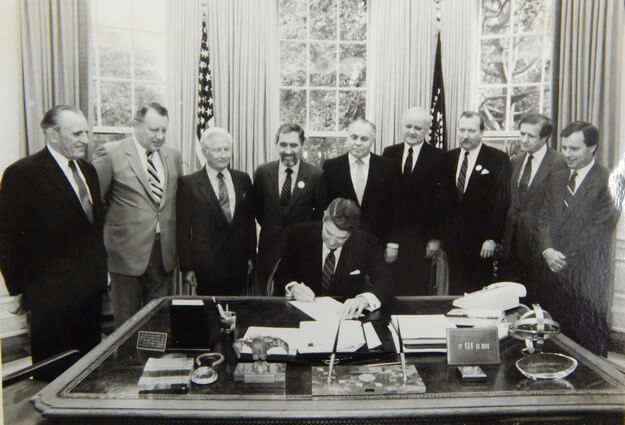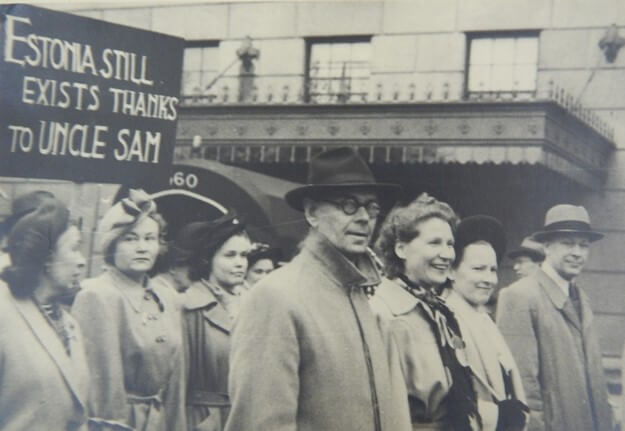
Baltic American delegation witnessing President Reagan’s signature on a proclamation designating June 14, 1986 as Baltic Freedom Day. Photo source: Estonian Archives in the U.S.
During this week leading up to the 75th anniversary of the final day, on September 22, 1944, that the majority of Estonians were able to flee our homeland before the incoming Soviet invasion, the Estonian American National Council would like to honor all Estonian Americans who were part of the Suur Põgenemine, or Great Refugee Flight of 1944, and express gratitude to all who assisted Estonian refugees along their way to reach safety.
It was those brave souls and their commitment to Estonia’s freedom that kept EANC, and the Estonian diaspora in the U.S., thriving through four decades of Soviet occupation. Below is a review of EANC’s history during the Soviet period, built on that commitment of the refugee generation and their children.
EANC was born in 1952 from the need for a single national organization to unify and lead Estonians exiled in the U.S. in their pursuit to restore Estonia as a free nation. Its 67-year history of cultural and language preservation, and advocacy in the U.S., throughout the changing landscape of Estonia’s occupation, its struggle for independence, and its evolution into a partner on the world stage, was accomplished by refugees. EANC’s founding aim was to coordinate efforts in fighting communism and liberating Estonia, along with the other nations trapped behind the Iron Curtain.
In the early years, Estonians who came to the U.S. had fresh memories of the trauma of the war, of the struggles of leaving, of family left behind, and of Estonia as a free nation.
While still working to establish themselves in their new home country, many were motivated by strong feelings of injustice and purpose to engage with the U.S. government and the broader public, first to educate them on where Estonia was, and second, to raise awareness that Estonia, and half of Europe, had unlawfully fallen under repressive Soviet rule. The 1940 Welles Declaration, issued by acting Secretary of State Sumner Welles, established the U.S. policy of nonrecognition of the Soviet annexation of the Baltic nations, and provided a foundation for these refugees’ advocacy work.
Early advocacy successes tended to be more symbolic than substantial, and they often came from cooperation among groups of diaspora activists from many nations. Estonian Americans were active in groups like the Assembly of Captive European Nations (ACEN), which was formed in New York in 1954 with offices located intentionally across the street from the United Nations headquarters as a daily reminder to the global community of the ongoing occupations in Europe.
It represented communities from nine captive nations (Albania, Bulgaria, Czechoslovakia, Estonia, Hungary, Latvia, Lithuania, Poland and Romania), and its goals were the peaceful liberation of their nations from communist rule – through educating public opinion on the realities of life behind the Iron Curtain – and enlisting the cooperation and support of the U.S. and other governments and NGOs in working toward this liberation.
Highlights of the new diaspora’s advocacy work included several presidential level efforts.
The Eisenhower administration posed a challenge as it pursued a policy of so-called peaceful liberation in parallel with the Soviet Union’s goal of “peaceful coexistence” with the West. The relationship between the two powers was fragile, and U.S. policy fell short of taking decisive action on behalf of Baltic freedom, so the goal of getting the government to move beyond strong rhetoric remained elusive.
They found some success in 1975 when Baltic leaders met with President Ford about that year’s Helsinki Conference, fearing he might abandon the U.S. policy of nonrecognition, permanently selling out the three counties to placate Moscow. After a demonstration on the National Mall that drew Members of Congress, including Senator Bob Dole, and over 4,000 protesters, President Ford held his ground at the August Conference and reaffirmed the policy, to the relief and celebration of the Estonian American community.

Estonians demonstrating in a 1950 parade; location unknown. Photo source: Estonian Archives in the U.S.
The 1980 Moscow Olympics prompted EANC to lead a grassroots letter campaign that got President Carter’s attention. The letters protested the International Olympic Committee’s approval of Tallinn as the site for the games’ sailing competitions. They noted that the Soviet government’s agenda included showing Estonia’s annexation as a foregone conclusion, defying the principles of the Olympic Games and casting doubt on the Estonian people’s right to self-determination. While the primary basis for President Carter’s ultimate decision to boycott the games was the Soviet invasion of Afghanistan, he wrote a letter of thanks to the EANC president for Estonian American support, and in it, he cited the status of Estonia and issues concerning dissidents as factors that contributed to his decision.
The Reagan years finally began the process of real change that Estonian Americans had been fighting for. Baltic Americans in California had been strong supporters of Governor Reagan and quickly established ties with his White House staff. Legislation that called for his 1982 designation of June 14th as Baltic Freedom Day, commemorating the mass deportations of Baltic citizens in 1941, was another victory for Baltic advocacy.
The approaching 50th anniversary of the 1939 Molotov-Ribbentrop pact that divided Eastern Europe again raised awareness of the injustices that led to the annexation of the Baltic nations, leading to Black Ribbon Day observances by Estonian and Baltic communities around the U.S. EANC also worked during this time to focus Congress on the fate of imprisoned Estonian political dissidents, an issue that many Representatives increasingly spoke out against. The 1980s was a decade of mushrooming Estonian American activism that eventually led to its ultimate goal.
Once Estonia reestablished independence in 1991, EANC was involved in the transitional period, helping to form a temporary government structure in Tallinn and formally insisting on legal continuity of the original Estonian Republic. They demanded restoration of the terms of the 1920 Tartu Peace Treaty, in which Soviet Russia recognized the Republic of Estonia and renounced forever all rights over the nation, and which they clearly violated with their military occupation. EANC pushed Congress to call for removal of Soviet troops from Estonian territory and called on the U.S. government to provide assistance in establishing all key areas of the new democratic government.
The Estonian diaspora’s contributions to the nation’s struggle for freedom were clearly recognized by the Estonian government. One member of the Estonian parliament said in 1998 that, “No one should underestimate the role of Estonians abroad” in restoring Estonia’s independence. The following year, former Prime Minister Mart Laar addressed a high-level meeting on Estonian security, “the Estonian nation will continue to need you.”
All of these efforts were the result of the work that Estonians who were forced to flee their homeland undertook to restore the independence of the country they loved. EANC is grateful to the dedicated members of the Estonian American community who never lost sight of their ultimate goal. Though there are many who passed before they could witness the restoration of Estonian independence in 1991, their impact, along with those still with us and those who were able to return to a free Estonia in their lifetime, is not forgotten. As the 75th anniversary of their departure is upon us, EANC commends all who kept Estonia’s flame burning here in the U.S. and looks to their example as we continue our work to ensure that flame remains strong.
Karin Shuey
Washington, DC Director
Estonian American National Council
www.estosite.org












